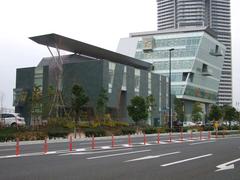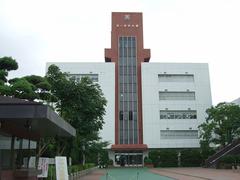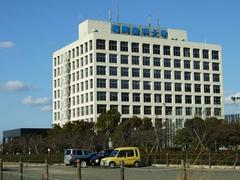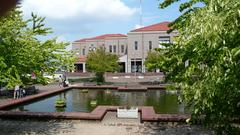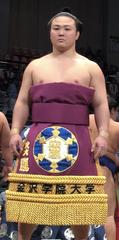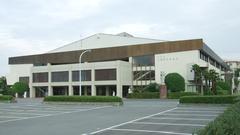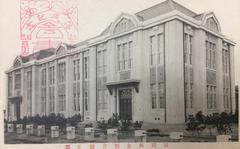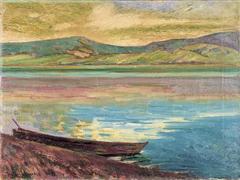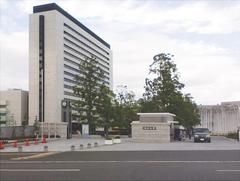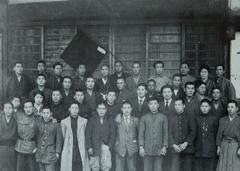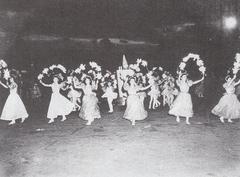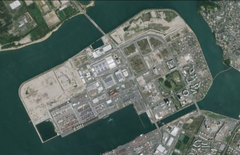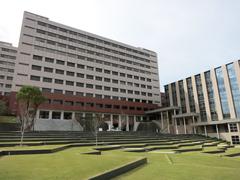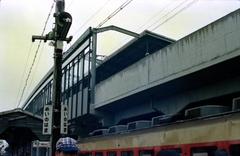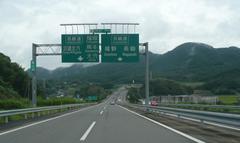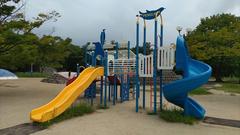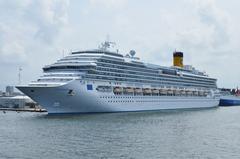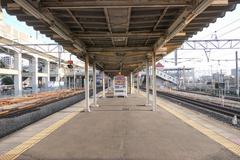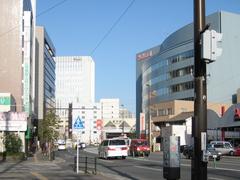Fukuoka Castle Visiting Hours, Tickets, and Travel Guide
Date: 14/06/2025
Introduction: Fukuoka Castle’s Historical Significance
Fukuoka Castle—also known as Maizuru Castle—occupies a prominent place in the heart of Fukuoka City, symbolizing the region’s samurai heritage and the architectural sophistication of Japan’s feudal era. Built between 1601 and 1607 under the guidance of Kuroda Nagamasa, a pivotal figure following the Battle of Sekigahara, the castle once served as the military and administrative center of the Chikuzen domain. Though the original main keep has not survived, the expansive ruins within Maizuru Park, including stone walls, gates, and turrets, continue to immerse visitors in Japan’s feudal past and offer a stunning spectacle each spring when over 1,000 cherry trees bloom (Wikipedia; Crossroad Fukuoka; Japan Guide; Agoda; WAmazing; Yen Travels Japan; TravelSetu).
Quick Reference: Fukuoka Castle Essentials
| Detail | Information |
|---|---|
| Location | Maizuru Park, central Fukuoka City |
| Visiting Hours | Daily, 9:00 AM–5:00 PM (last entry 4:30 PM); park open 6:00 AM–7:00 PM (seasonal) |
| Admission | Free for castle ruins and Maizuru Park; some exhibitions/turrets may charge a small fee |
| Accessibility | Mostly wheelchair/stroller accessible; some stone steps and slopes; restrooms available |
| Best Time | Late March–early April (cherry blossom season); autumn for foliage |
| Nearby Transit | Ohorikoen Station (Fukuoka City Subway), 5–10 min walk |
| Official Site | Fukuoka Castle Official Info |
Origins and Architectural Innovations
Fukuoka Castle, also called Fukuoka-jō or Maizuru Castle, was a strategic and administrative stronghold. Its location on Fukuzaki hill between the Naka River and what is now Ohori Park provided natural defenses and panoramic views over the region (rekishinihon.com). Kuroda Nagamasa, rewarded for his loyalty at Sekigahara, constructed the castle with support from influential local merchants and artisans, recycling stone from the Genko Borui and Najima Castle (Wikipedia).
The castle’s Teikaku-shiki layout featured massive stone ramparts, 47 turrets, and 12 gates, with the main bailey (honmaru) at its core. The complex spanned approximately 470,000 square meters, making it one of Kyushu’s largest castles, rivaling Himeji and Kumamoto Castles (Bespes JT). Defensive features included thick stone walls—designed by famed stonemason Noguchi Kazunari—and strategic placement of Buddhist temples for both spiritual and military purposes (Wikipedia).
Cultural and Political Role
Fukuoka Castle was the seat of the Kuroda clan for over two centuries, overseeing the administration and defense of the Chikuzen domain. Its proximity to Hakata, a major trading port, fostered economic prosperity and cultural exchange, shaping Fukuoka’s development into a vibrant commercial hub (realestate-fukuoka.yes-fudousan.com). The castle town was carefully planned to slow potential invaders and blend religious, administrative, and residential functions.
Decline, Preservation, and Modern Legacy
Like many Japanese castles, Fukuoka Castle’s main keep was lost during the Meiji Restoration, with much of the grounds repurposed as Maizuru Park. Remaining structures—including the Tamon Yagura turret (a National Important Cultural Property), stone walls, and gates—have been restored and preserved. Archaeological discoveries, such as the Korokan guesthouse for foreign envoys, add further historical depth (Crossroad Fukuoka).
Today, the castle ruins and park serve as a major recreational and cultural space, hosting seasonal festivals, cherry blossom viewing, and educational programs. The site is beloved by locals and visitors, particularly during spring hanami and autumn foliage (Agoda; WAmazing).
Visiting Fukuoka Castle: Hours, Tickets, and Tips
Hours and Admission
- Castle Ruins & Maizuru Park: Open daily, 9:00 AM–5:00 PM (last entry 4:30 PM). Park generally accessible 6:00 AM–7:00 PM year-round.
- Tamon Yagura Turret & Exhibitions: Open during events or special seasons; small fee may apply.
Admission:
- Free entry to castle ruins and Maizuru Park
- Special exhibitions and some turrets may require a ticket (check official sources for current details)
Accessibility
- Most paths are paved and suitable for wheelchairs and strollers; some areas have stone steps or uneven ground.
- Rest areas and modern restrooms are available.
- Signage in English and Japanese.
Getting There
- Subway: Ohorikoen Station (Fukuoka City Subway), about a 5–10 minute walk to the park entrance.
- Bus: Multiple city bus lines serve the area.
- Taxi: Readily available from major city locations.
Visitor Experience: What to See and Do
-
Stone Walls and Gates: Explore the extensive ruins, including the Otemon Gate and impressive ramparts.
-
Tamon Yagura: The only surviving Edo-period turret, open during special events.
-
Observation Deck: Ascend the stone foundation of the main keep for panoramic city and bay views.
-
Korokan Ruins Museum: Discover Fukuoka’s ancient diplomatic history.
-
Seasonal Highlights:
- Cherry Blossoms (late March–April): Over 1,000 sakura trees in bloom, evening light-ups, and hanami festivals.
- Autumn Foliage (late September–December): Brilliant leaf color and tranquil atmosphere.
- Cultural Events: Music, dance, and food festivals throughout the year.
-
Digital Enhancements: AR apps and audio guides in multiple languages enrich the historical experience (TravelSetu).
Nearby Attractions
- Ohori Park: Adjacent to Fukuoka Castle, this vast green space features a large pond, walking trails, pedal boats, and a Japanese garden (Living Nomads; MATCHA).
- Fukuoka Art Museum: Houses modern and Asian art, including works by Salvador Dalí (Tourist Japan).
- Tenjin Shopping District: Bustling commercial quarter with underground malls, boutiques, and restaurants (TravelSetu).
- Fukuoka Tower: Panoramic city and bay views from Japan’s tallest seaside tower (MATCHA).
- Canal City Hakata: Large entertainment and shopping complex with Ramen Stadium (Living Nomads).
- Dazaifu Tenmangu Shrine: Celebrated shrine dedicated to the deity of learning (MATCHA).
- Nanzoin Temple: Home to the world’s largest reclining Buddha (Tourist Japan).
- Uminonakamichi Seaside Park: Family-friendly park with gardens, cycling, and an aquarium (MATCHA).
Suggested Itineraries
Half-Day
- Fukuoka Castle Ruins and Maizuru Park
- Ohori Park stroll and Japanese Garden
- Fukuoka Art Museum or Tenjin shopping
Full-Day
- Morning: Castle ruins, Korokan Museum
- Midday: Ohori Park, Fukuoka Art Museum
- Afternoon: Fukuoka Tower, Momochi Seaside Park
- Evening: Tenjin or Nakasu yatai street food
2–3 Day In-Depth
- Day 1: Central Fukuoka sights
- Day 2: Dazaifu Tenmangu Shrine, Nanzoin Temple
- Day 3: Uminonakamichi Seaside Park, Canal City Hakata, local food experiences
Practical Tips
- Transport: Utilize Fukuoka’s efficient subway and bus systems. Day passes available (Living Nomads).
- Seasonal Advice: Visit in spring for cherry blossoms or autumn for foliage; weekdays and early mornings are quieter.
- Dining: Sample Hakata ramen at local yatai or Canal City’s Ramen Stadium.
- Accessibility: Most attractions are within a 2–4 km radius of the castle.
- Cultural Experiences: Guided tours and kimono rentals available (Living Nomads).
Visuals and Media Recommendations
- Cherry blossoms at Fukuoka Castle (alt: “Fukuoka Castle ruins with cherry blossoms in spring”)
- Panoramic city views from the observation deck (alt: “View from Fukuoka Castle over city and bay”)
- Night illuminations of Tamon Yagura (alt: “Tamon Yagura turret illuminated at night”)
- Ohori Park pond and gardens (alt: “Ohori Park pond and traditional Japanese garden”)
- Dazaifu Tenmangu Shrine architecture (alt: “Red torii at Dazaifu Tenmangu Shrine”)
Frequently Asked Questions (FAQ)
Q: What are the Fukuoka Castle visiting hours?
A: Daily, 9:00 AM–5:00 PM (last entry 4:30 PM); Maizuru Park open 6:00 AM–7:00 PM.
Q: Is admission free?
A: Yes, for castle ruins and Maizuru Park. Exhibitions or turrets may charge a small fee.
Q: Are guided tours available?
A: Yes, both in-person and audio guides, available in multiple languages.
Q: How do I get there on public transport?
A: Use the Fukuoka City Subway to Ohorikoen Station or Akasaka Station, then walk.
Q: When is the best time to visit?
A: Late March–early April for cherry blossoms, autumn for foliage.
Q: Is the site accessible for wheelchairs and strollers?
A: Most main paths are accessible; some areas have steps or uneven ground.
Conclusion
Fukuoka Castle stands as a living testament to the city’s samurai past, architectural excellence, and cultural resilience. Its scenic grounds and preserved ruins offer a unique blend of history and natural beauty, especially during seasonal festivals. With free access, convenient transport, multilingual guides, and proximity to Fukuoka’s major attractions, the castle is an essential stop for any visitor.
For the latest event updates and guided experiences, download the Audiala app and follow our social media channels. Continue your exploration with our related guides on Fukuoka’s historical sites, parks, and culinary hotspots, and make your journey in Fukuoka unforgettable.
Sources and Further Reading
- Wikipedia, 2024, Fukuoka Castle
- Crossroad Fukuoka, 2024, Fukuoka Castle
- Japan Guide, 2024, Fukuoka Castle
- Agoda, 2024, Fukuoka Castle Cherry Blossom Guide
- Yen Travels Japan, 2024, Fukuoka Castle Historical Guide
- TravelSetu, 2024, Fukuoka Castle Ruins Tourism History
- WAmazing, 2024, Fukuoka Castle Article
- Bespes JT, 2024, Fukuoka Castle Architecture and History
- Happy Jappy, 2024, Fukuoka Castle Ruins Guide
- Living Nomads, 2025, Best Places to Visit in Fukuoka
- MATCHA, Fukuoka Travel Guide
- Tourist Japan, Fukuoka Guide

